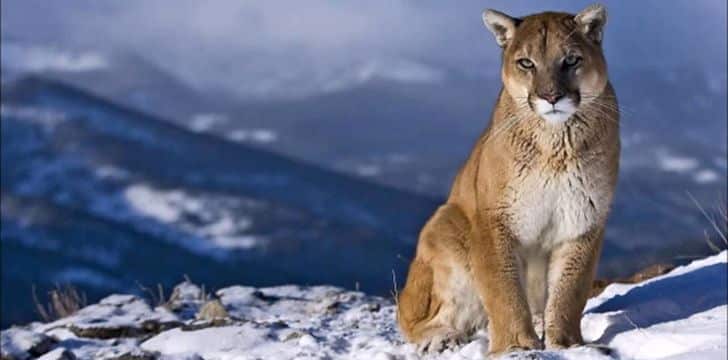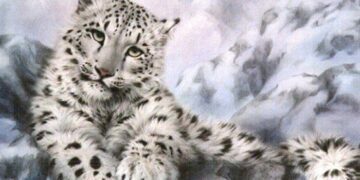While cougars may look like a giant version of your house cat, they are certainly not the type of animal you would want to cuddle with!
Still, we can admire them from afar, and hope we don’t run into one on a dark night in the forest.
Here we have 30 facts about these impressive giant cats!
Cougars are known by 40 different names in English alone. The most popular names for cougars are mountain lions, pumas, or panthers.
The main food sources for pumas are large mammals such as deer, moose, horses, and sheep. However, they will also hunt small species like insects and rodents.
Mountain lions are found from the Canadian Yukon, all the way down to the southern Andes in South America.
Because of their adaptability, they are the most widely distributed earthbound mammal in the Western Hemisphere.
Other than humans, no species prey upon fully grown cougars in the wild.
Pumas can reach speeds up to 45 mph (72 km/h), but they do best at short and powerful sprints as opposed to long distance runs.
On average, cougars grow to between 5 and 9 feet (1.5 to 2.75 meters) in length, while their height reaches 2 to 2.5 feet (60 to 76 centimeters).
Mature male cougars can weigh up to 200 pounds (90 kg), while mature females only weigh up to 120 pounds (54 kg).
In the wild, cougars live to be around 10 years old. However, when in captivity, they can live to up 20 years!
The mountain lion is the fourth heaviest cat in the world, behind the tiger, lion, and jaguar.
Even though cougars are good swimmers, they prefer not to go into water.
Having long hind legs allows mountain lions to jump as far forward as 40 feet (12 meters)! They can jump up to 18 feet (5.4 meters) vertically from a sitting position.
There are 6 subspecies of cougar, all named according to their location, such as the Eastern cougar, or the Florida panther.
Like most cat species, cougars are solitary, interacting only to mate and raise their young.
Female pumas give birth to 2-3 kittens at a time. On average, only one out of six cubs survives to maturity.

Cougar cubs are covered in black spots from birth until about 6 months old when they fade. These spots act as camouflage to help the cubs blend in to their surroundings while they’re young.
Cougars have a bad sense of smell, but fantastic night vision.
After a kill, mountain lions will hide the portion of the carcass that they don’t eat and save it for later!
Often, they hide their kill in the same spot, hiding it by covering it with sticks and leaves.
Cougars hunt one large mammal once every two weeks.
Cougars are typically active around dawn and dusk, making them crepuscular mammals.
Cougar’s sizes vary depending on their location. Cougars that live closer to the equator are general smaller, with their size increasing the further away they are.
Despite their impressive size, puma’s cannot roar, but instead they purr! They are the biggest cat that can purr and meow. This is probably due to the fact that they are more closely related to domestic cats, rather than other large cats like lions and tigers.
Due to cougar’s prey being mostly herbivores, the seeds in the stomach of their victims will be spread through the cougar’s scat. This results in cougars unintentionally planting over 90,000 plants per year!
Pumas are extremely territorial, often dominating home ranges up to 150 square miles (240 km).
More often than not, mountain lions won’t attack humans unless they feel threatened.
When it comes to hunting, cougars will stalk their prey then pounce and attack their victim’s throat or back of the next.
Cougar’s tails average around 33 inches (83 cm) which helps keep them balanced.
It is difficult to get an accurate count of how many cougars are in the wild because they remain so well hidden. By approximation, there are about 50,000 cougars in the wild.
While certain populations of mountain lions have dropped, there is still a large amount of cougars out there – so much so, that their species is still at a least concern.

















